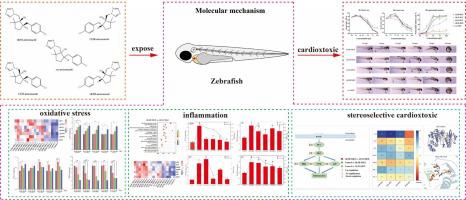当前位置:
X-MOL 学术
›
Sci. Total Environ.
›
论文详情
Our official English website, www.x-mol.net, welcomes your
feedback! (Note: you will need to create a separate account there.)
Stereoselective cardiotoxic effects of metconazole on zebrafish (Danio rerio) based on AGE-RAGE signalling pathway
Science of the Total Environment ( IF 8.2 ) Pub Date : 2023-12-19 , DOI: 10.1016/j.scitotenv.2023.169304
Minmin Li 1 , Lin Yang 2 , Rui Wang 1 , Lin Li 1 , Yifan Zhang 1 , Long Li 1 , Nuo Jin 1 , Yatao Huang 1 , Zhiqiang Kong 3 , Frédéric Francis 4 , Bei Fan 1 , Fengzhong Wang 1
Science of the Total Environment ( IF 8.2 ) Pub Date : 2023-12-19 , DOI: 10.1016/j.scitotenv.2023.169304
Minmin Li 1 , Lin Yang 2 , Rui Wang 1 , Lin Li 1 , Yifan Zhang 1 , Long Li 1 , Nuo Jin 1 , Yatao Huang 1 , Zhiqiang Kong 3 , Frédéric Francis 4 , Bei Fan 1 , Fengzhong Wang 1
Affiliation

|
Metconazole (MEZ) is a novel chiral triazole fungicide that is widely used to prevent and control soil-borne fungal pathogens and other fungal diseases. However, it has a long half-life in aquatic environments and thus poses potential environmental risks. This study evaluates the acute and stereoselective cardiotoxicity of MEZ in zebrafish (Danio rerio) embryos. In addition, transcriptomics, real-time quantitative PCR, enzyme activity determination, and molecular docking are performed to evaluate the molecular mechanisms underlying the cardiotoxicity of MEZ in zebrafish. MEZ decreases the heart rate while increasing the pericardial oedema rate; additionally, it induces stereoselective cardiotoxicity. 1S ,5S -MEZ exhibits stronger cardiotoxicity than 1R ,5R -MEZ. Furthermore, MEZ increases the expression of Ahr-associated genes and the transcription factors il6st , il1b , and AP-1 . Heart development-related genes, including fbn2b , rbm24b , and tbx20 are differentially expressed. MEZ administration alters the activities of catalase, peroxidase, and glutathione-S -transferase in zebrafish larvae. Molecular docking indicates that 1R ,5R -MEZ binds more strongly to the inhibitor-binding sites of p38 in the AGE-RAGE signalling pathway than to other MEZ enantiomers. Studies conducted in vivo and in silico have established the enantioselective cardiotoxicity of MEZ and its underlying mechanisms, highlighting the need to evaluate the environmental risk of chiral MEZ in aquatic organisms at the enantiomeric level.
中文翻译:

基于AGE-RAGE信号通路的叶菌唑对斑马鱼的立体选择性心脏毒性作用
乙菌唑(MEZ)是一种新型手性三唑类杀菌剂,广泛用于防治土传真菌病原菌及其他真菌病害。然而,它在水生环境中的半衰期较长,因此存在潜在的环境风险。本研究评估了 MEZ 对斑马鱼 (Danio rerio) 胚胎的急性和立体选择性心脏毒性。此外,还通过转录组学、实时定量 PCR、酶活性测定和分子对接来评估 MEZ 对斑马鱼心脏毒性的分子机制。 MEZ降低心率,同时增加心包水肿率;此外,它还会引起立体选择性心脏毒性。 1S,5S-MEZ 比 1R,5R-MEZ 表现出更强的心脏毒性。此外,MEZ 增加 Ahr 相关基因和转录因子 il6st、il1b 和 AP-1 的表达。心脏发育相关基因,包括 fbn2b、rbm24b 和 tbx20 存在差异表达。 MEZ 管理改变斑马鱼幼虫过氧化氢酶、过氧化物酶和谷胱甘肽-S-转移酶的活性。分子对接表明,1R,5R-MEZ 与 AGE-RAGE 信号通路中 p38 抑制剂结合位点的结合比与其他 MEZ 对映体的结合更强。体内和计算机研究已经确定了 MEZ 的对映选择性心脏毒性及其潜在机制,强调需要在对映体水平上评估水生生物中手性 MEZ 的环境风险。
更新日期:2023-12-19
中文翻译:

基于AGE-RAGE信号通路的叶菌唑对斑马鱼的立体选择性心脏毒性作用
乙菌唑(MEZ)是一种新型手性三唑类杀菌剂,广泛用于防治土传真菌病原菌及其他真菌病害。然而,它在水生环境中的半衰期较长,因此存在潜在的环境风险。本研究评估了 MEZ 对斑马鱼 (Danio rerio) 胚胎的急性和立体选择性心脏毒性。此外,还通过转录组学、实时定量 PCR、酶活性测定和分子对接来评估 MEZ 对斑马鱼心脏毒性的分子机制。 MEZ降低心率,同时增加心包水肿率;此外,它还会引起立体选择性心脏毒性。 1S,5S-MEZ 比 1R,5R-MEZ 表现出更强的心脏毒性。此外,MEZ 增加 Ahr 相关基因和转录因子 il6st、il1b 和 AP-1 的表达。心脏发育相关基因,包括 fbn2b、rbm24b 和 tbx20 存在差异表达。 MEZ 管理改变斑马鱼幼虫过氧化氢酶、过氧化物酶和谷胱甘肽-S-转移酶的活性。分子对接表明,1R,5R-MEZ 与 AGE-RAGE 信号通路中 p38 抑制剂结合位点的结合比与其他 MEZ 对映体的结合更强。体内和计算机研究已经确定了 MEZ 的对映选择性心脏毒性及其潜在机制,强调需要在对映体水平上评估水生生物中手性 MEZ 的环境风险。





































 京公网安备 11010802027423号
京公网安备 11010802027423号